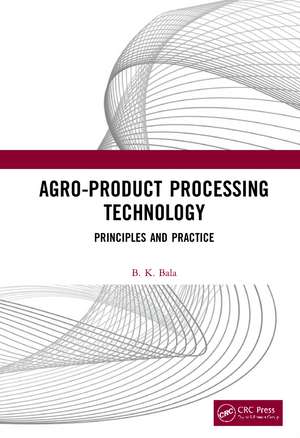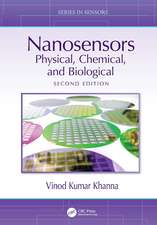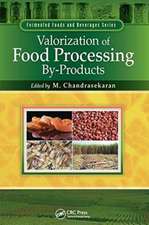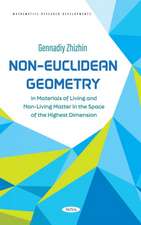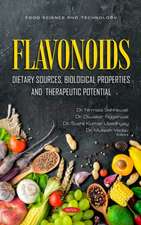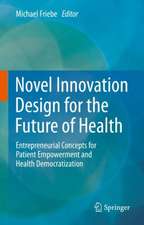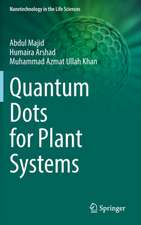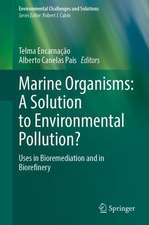Agro-Product Processing Technology: Principles and Practice
Autor B K Balaen Limba Engleză Hardback – 20 apr 2020
Features:
- Covers a wide spectrum of agro-product processing technology
- Explains the principles and practices of agro-product processing technology with many worked examples to quickly teach the basic principles through examples
- Contains examples from different operations on current problems to show the wide applications of the principles of agro-product technology
- Includes process control and emerging technologies in agro-product processing such as energy and exergy analysis, neural network modeling, and CFD modeling
Preț: 1544.82 lei
Preț vechi: 1883.93 lei
-18% Nou
Puncte Express: 2317
Preț estimativ în valută:
295.61€ • 310.05$ • 246.08£
295.61€ • 310.05$ • 246.08£
Carte tipărită la comandă
Livrare economică 01-15 aprilie
Preluare comenzi: 021 569.72.76
Specificații
ISBN-13: 9781138596689
ISBN-10: 113859668X
Pagini: 420
Ilustrații: 207
Dimensiuni: 178 x 254 x 24 mm
Greutate: 0.45 kg
Ediția:1
Editura: CRC Press
Colecția CRC Press
ISBN-10: 113859668X
Pagini: 420
Ilustrații: 207
Dimensiuni: 178 x 254 x 24 mm
Greutate: 0.45 kg
Ediția:1
Editura: CRC Press
Colecția CRC Press
Cuprins
Contents
Foreword ..........................................................................................................................................xv
Preface............................................................................................................................................xvii
Author .............................................................................................................................................xix
Chapter 1 Introduction ..................................................................................................................1
1.1 Introduction .........................................................................................................1
1.2 Impotence of Postharvest Technology .................................................................2
1.3 Importance of Postharvest Losses .......................................................................2
1.4 Postharvest Technology .......................................................................................3
References ....................................................................................................................5
Chapter 2 Physical, Thermal, and Chemical Properties of Food and Biological Materials .........7
2.1 Introduction .........................................................................................................7
2.2 Physical Properties ..............................................................................................7
2.2.1 Physical Dimensions ................................................................................7
2.2.2 1000-Grain Weight ..................................................................................7
2.2.3 Bulk Density ............................................................................................8
2.2.4 Shrinkage .................................................................................................8
2.2.5 Friction ....................................................................................................9
2.2.5.1 Angle of Internal Friction and Angle of Repose ......................9
2.2.5.2 Coefficient of Friction ............................................................. 10
2.3 Thermal Properties ............................................................................................ 11
2.3.1 Specific Heat .......................................................................................... 11
2.3.2 Thermal Conductivity ........................................................................... 13
2.3.2.1 Theory ..................................................................................... 13
2.3.2.2 Apparatus and Measurement .................................................. 14
2.3.3 Latent Heat of Vaporization .................................................................. 15
2.3.3.1 Determination of Latent Heat of Vaporization ....................... 16
2.3.4 Heat Transfer Coefficient of Product Bed ............................................. 18
2.3.4.1 Dimensional Analysis ............................................................. 19
2.3.4.2 Comparison of Theory and Experiment ................................. 19
2.3.4.3 Theory .....................................................................................20
2.3.4.4 Determination of Volumetric Heat Transfer Coefficient ........22
2.4 Chemical Properties ..........................................................................................24
2.4.1 Starch .....................................................................................................24
2.4.2 Protein ...................................................................................................24
2.4.3 Fat ..........................................................................................................24
2.4.4 Vitamin ..................................................................................................24
Key to Symbols ..........................................................................................................24
Exercises .....................................................................................................................26
References ..................................................................................................................27
Chapter 3 Cleaning, Grading, and Sorting .................................................................................29
3.1 Grade Factor ....................................................................................................29
3.2 Washing ...........................................................................................................30
3.3 Sorting Fruits and Vegetables ..........................................................................30
3.4 Sorting Grain ...................................................................................................30
3.5 Spiral Separator ............................................................................................... 32
3.6 Indent Cylinder Separator ............................................................................... 33
3.7 Color Separator ................................................................................................ 33
3.8 Centrifugal Separation ....................................................................................34
3.8.1 Stokes’ Equation .................................................................................34
3.9 The Centrifuge................................................................................................. 35
3.10 The Cream Separator ....................................................................................... 35
3.11 Cyclone Separator ............................................................................................36
3.12 Machine Vision................................................................................................ 39
3.12.1 Image Acquisition ............................................................................. 39
3.12.1.1 Computer Vision System .................................................. 39
3.12.1.2 Ultrasound and Infrared ...................................................40
3.12.1.3 Tomographic Imaging ......................................................40
3.12.2 Preprocessing ....................................................................................40
3.12.3 Segmentation ..................................................................................... 41
3.12.4 Feature Extraction ............................................................................. 42
3.12.4.1 Color Features .................................................................. 42
3.12.4.2 Morphological Features.................................................... 43
3.12.4.3 Texture Features ............................................................... 43
3.12.5 Classification .....................................................................................44
Bibliography ............................................................................................................... 45
Chapter 4 Psychrometry .............................................................................................................. 47
4.1 Introduction ..................................................................................................... 47
4.2 Psychrometric Terms ....................................................................................... 47
4.2.1 Humidity Ratio ..................................................................................48
4.2.2 Relative Humidity .............................................................................48
4.2.3 Specific Volume ................................................................................49
4.2.4 Vapor Pressure ..................................................................................49
4.2.5 Dry-Bulb Temperature ......................................................................49
4.2.6 Dew Point Temperature.....................................................................49
4.2.7 Wet-Bulb Temperature ......................................................................49
4.2.8 Enthalpy ............................................................................................50
4.2.9 Adiabatic Wet-Bulb Temperature ...................................................... 51
4.2.10 Psychrometric Wet-Bulb Temperature .............................................. 52
4.3 Construction of Psychrometric Chart ..............................................................54
4.4 Use of Psychrometric Chart ............................................................................54
4.4.1 Sensible Heating and Cooling ........................................................... 55
4.4.2 Heating with Humidification ............................................................. 55
4.4.3 Cooling with Humidification ............................................................56
4.4.4 Cooling with Dehumidification.........................................................56
4.4.5 Drying ............................................................................................... 57
4.4.6 Mixing of Airstreams ....................................................................... 59
4.4.7 Heat Addition with Air Mixing .......................................................... 61
4.4.8 Drying with Recirculation .................................................................. 62
Key to Symbols ..........................................................................................................66
Exercises .....................................................................................................................68
Bibliography ...............................................................................................................68
Chapter 5 Drying of Agro Products ............................................................................................69
5.1 Principles of Drying ..........................................................................................69
5.2 Importance of Drying ........................................................................................69
5.3 Moisture Content ............................................................................................... 70
5.3.1 Moisture Content Representation .......................................................... 70
5.3.2 Determination of Moisture Content ...................................................... 72
5.3.2.1 Direct Methods ....................................................................... 73
5.3.2.2 Indirect Methods ..................................................................... 75
5.4 Equilibrium Moisture Content .......................................................................... 76
5.4.1 Determination of Static Equilibrium Moisture Content ........................77
5.4.2 Static Equilibrium Moisture Content Models .......................................77
5.5 Mechanism of Drying........................................................................................82
5.6 Thin-Layer Drying ............................................................................................84
5.6.1 Thin-Layer Drying Equations ...............................................................84
5.6.1.1 Empirical Drying Equations ...................................................84
5.6.1.2 Theoretical Drying Equations ................................................84
5.6.1.3 Semi-Theoretical Drying Equations .......................................85
5.6.2 Drying Rate ...........................................................................................87
5.6.3 Drying Parameters .................................................................................87
5.6.4 Drying Rate Constant and Diffusion Coefficient ..................................88
5.6.4.1 Drying Rate Constant .............................................................88
5.6.5 Half Response Time .............................................................................. 91
5.7 Deep-Bed Drying ..............................................................................................92
5.7.1 Logarithmic Model ................................................................................92
5.7.2 Partial Differential Equation Model ......................................................98
5.7.2.1 Method of Solution ............................................................... 102
5.7.2.2 Comparisons of Simulated and Observed Results ................ 103
5.8 Fluidized Bed Drying Model .......................................................................... 103
5.8.1 Heat Balance Equation ........................................................................ 104
5.8.2 Drying Rate Equation .......................................................................... 104
5.8.3 Mass Balance Equation ....................................................................... 105
5.9 Agro-Product Drying Systems ........................................................................ 106
5.9.1 Solar Drying Systems .......................................................................... 106
5.9.1.1 Solar Dryers .......................................................................... 106
5.9.2 Batch Drying Systems ......................................................................... 110
5.9.2.1 Flatbed Dryer ........................................................................ 111
5.9.3 Continuous Flow Drying Systems ....................................................... 113
5.9.3.1 Cross-Flow Dryer ................................................................. 113
5.9.3.2 Cross-Flow Batch Dryer ....................................................... 113
5.9.3.3 Concurrent Flow Dryer ......................................................... 114
5.9.3.4 Counterflow Dryer ................................................................ 114
5.9.3.5 Mixed-Flow Dryer ................................................................ 116
5.10 Safe Temperature for Drying Grain .............................................................. 117
5.11 Selection of Dryers ........................................................................................ 117
Key to Symbols ........................................................................................................ 118
Exercises ................................................................................................................... 119
Bibliography ............................................................................................................. 120
Chapter 6 Parboiling of Rice .................................................................................................... 123
6.1 Introduction ................................................................................................... 123
6.2 Principles of Parboiling .................................................................................124
6.3 Soaking ..........................................................................................................124
6.3.1 Kinetics of Soaking ........................................................................... 126
6.3.2 Finite Element Modeling of Soaking of Water by Paddy .................. 132
6.3.3 Half Response Time .......................................................................... 137
6.3.4 Kinetics of Water Diffusion and Starch Gelatinization .................... 137
6.4 Steaming ........................................................................................................ 140
6.5 Drying ............................................................................................................ 140
6.6 Effect of Parboiling on Milling, Nutritional, and Cooking Qualities
of Rice ........................................................................................................... 141
6.7 Parboiling Methods ....................................................................................... 142
6.7.1 Traditional Methods .......................................................................... 142
6.7.1.1 Single Stage Parboiling ...................................................... 142
6.7.1.2 Double Stage Parboiling ..................................................... 142
6.7.2 Modern Methods ............................................................................... 142
6.7.2.1 CFTRI (Central Food Technological Research
Industries) Method ............................................................. 143
6.7.2.2 Jadavpur University Method .............................................. 143
6.7.2.3 Malek Process .................................................................... 143
6.7.2.4 Schule Process .................................................................... 143
6.7.2.5 Crystal Rice Process .......................................................... 144
6.7.2.6 Rice Conversion Process .................................................... 144
6.7.2.7 Avorio Process .................................................................... 144
6.7.3 Estimation of Heat Required for Parboiling ...................................... 144
6.7.3.1 Soaking Operation.............................................................. 144
6.7.3.2 Steaming Operation............................................................ 144
6.7.3.3 Drying Operation ............................................................... 145
Exercises ................................................................................................................... 159
Bibliography ............................................................................................................. 160
Chapter 7 Milling of Rice and Wheat ....................................................................................... 163
7.1 Introduction ................................................................................................... 163
7.2 Rice Milling .................................................................................................. 163
7.3 Traditional Methods ...................................................................................... 163
7.3.1 Home Pounding ................................................................................. 163
7.3.2 Huller Mills ....................................................................................... 164
7.3.3 Sheller Mills ...................................................................................... 164
7.3.4 Rubber Roll Sheller Mills .................................................................. 164
7.4 The Modern Rice Milling Process ................................................................ 165
7.5 Modern Rice Milling Machinery .................................................................... 167
7.5.1 Paddy Cleaner ...................................................................................... 167
7.5.2 Stoner ................................................................................................... 167
7.5.3 Rubber Roll Sheller ............................................................................. 167
7.5.4 Paddy Separator ................................................................................... 169
7.5.5 Whitening or Polishing........................................................................ 171
7.5.5.1 Cone-Type Polisher ............................................................... 171
7.5.5.2 Horizontal Abrasive-Type Polisher ....................................... 172
7.5.5.3 Friction-Type Polisher ........................................................... 172
7.5.6 Bran and Polished Rice Separator ....................................................... 173
7.5.7 Rice Grader ......................................................................................... 173
7.5.8 Rice Mixing ......................................................................................... 174
7.6 Wheat Milling ................................................................................................. 174
7.6.1 Conditioning/Hydrothermal Treatment ............................................... 174
7.6.2 Milling ................................................................................................. 174
7.6.3 Storage of Finished Products ............................................................... 175
7.7 Size Characteristics ......................................................................................... 175
7.7.1 Sieve ..................................................................................................... 175
7.7.2 Fineness Modulus ................................................................................ 176
7.7.3 Energy Requirements .......................................................................... 177
Bibliography ............................................................................................................. 179
Chapter 8 By-Product Utilization ............................................................................................. 181
8.1 Introduction ..................................................................................................... 181
8.2 Fuels and Combustion ..................................................................................... 181
8.2.1 Furnaces .............................................................................................. 182
8.3 Pyrolysis and Gasification ............................................................................... 183
8.3.1 Pyrolysis (Destructive Distillation) and Gasification .......................... 183
8.3.2 Types of Gasifiers ................................................................................ 184
8.3.2.1 Countercurrent Moving Bed Gasifiers .................................. 185
8.3.2.2 Concurrent Moving Bed Gasifiers ........................................ 185
8.3.2.3 Crosscurrent Moving Bed Gasifiers ..................................... 185
8.3.2.4 Fluidized Bed Gasifiers ........................................................ 185
8.3.3 Gasification Process ............................................................................ 185
8.3.3.1 Oxidation .............................................................................. 186
8.3.3.2 Reduction .............................................................................. 186
8.3.3.3 Drying ................................................................................... 186
8.3.4 Gasifier Units ....................................................................................... 186
8.4 Liquefaction ..................................................................................................... 187
8.5 Hydrolysis Followed by Fermentation ............................................................. 189
8.6 Biochar Production and Utilization ................................................................. 190
8.6.1 Biochar Carbonizer ............................................................................. 190
8.6.2 Types of Carbonizers ........................................................................... 191
8.6.2.1 Application............................................................................ 192
8.7 Rice Husk Pelletizing and Briquetting ............................................................ 192
8.7.1 Need for Briquetting ............................................................................ 193
8.7.2 Principle and Technology .................................................................... 193
8.7.3 Types of Briquetting Machines ....................................................... 193
8.7.3.1 High- and Medium-Pressure Compaction .......................194
8.7.3.2 Screw Press ...................................................................... 194
8.7.3.3 Piston Press ...................................................................... 195
8.7.3.4 Low-Pressure Compaction ............................................... 195
8.7.3.5 Hand-Molded Briquettes .................................................. 195
8.7.4 Applications ..................................................................................... 195
8.7.5 Limitations....................................................................................... 196
8.7.6 Future Prospective ........................................................................... 196
8.8 Biogas Digesters ............................................................................................ 196
8.8.1 Anaerobic Digestion Process ........................................................... 197
8.8.2 Indian-Type Biogas Digester ........................................................... 197
8.8.3 The Chinese Biogas Digester .......................................................... 198
8.8.4 Digester Sizing ................................................................................ 199
8.9 Composting ....................................................................................................202
8.9.1 Process of Composting ....................................................................203
8.9.2 Mixing of Materials in the Compost ...............................................203
8.9.3 Starting a Composter .......................................................................204
8.9.4 Operating a Compost .......................................................................204
8.9.5 Simple Thermophile Composting Procedure ..................................204
8.9.6 Types of Composters .......................................................................205
8.10 Utilization of Rice Bran – Stabilizer Design and Oil Extraction ..................207
8.11 Bran – Stabilizer Design ...............................................................................207
8.12 Oil Extraction ................................................................................................207
8.12.1 Batch Extraction Method .................................................................208
Bibliography .............................................................................................................208
Chapter 9 Storage of Agro Products .........................................................................................209
9.1 Principles of Storage ......................................................................................209
9.2 Interactions of Physical, Chemical, and Biological Variables in the
Deterioration of Stored Grains ...................................................................... 211
9.3 Computer Simulation Modeling for Stored Grain Pest Management ........... 212
9.4 Grain Storage Systems .................................................................................. 213
9.4.1 Traditional Storage Systems ............................................................ 213
9.4.2 Modern Storage Systems ................................................................. 214
9.4.2.1 Bagged Storage System .................................................... 214
9.4.2.2 Silo Storage System ......................................................... 215
9.4.2.3 Airtight Grain Storage ..................................................... 216
9.4.2.4 Aerated Storage System ................................................... 218
9.4.2.5 Low-Temperature Storage System (Grain Chilling
by Refrigeration) .............................................................. 221
9.4.2.6 Controlled Atmosphere Storage Systems ........................224
9.4.2.7 Damp Grain Storage System with Chemicals .................226
9.5 Design of Grain Storages...............................................................................228
9.5.1 Structural Requirements ..................................................................228
9.5.2 Janssen’s Equation ...........................................................................229
9.5.3 Rankine’s Equation.......................................................................... 232
9.5.4 Airy’s Equation ................................................................................ 233
9.5.5 Construction Materials ....................................................................236
Key to Symbols ........................................................................................................240
Exercises ................................................................................................................... 241
Bibliography ............................................................................................................. 241
Chapter 10 Heating and Cooling of Agro Products ....................................................................245
10.1 Introduction ....................................................................................................245
10.2 Heat Conduction ............................................................................................246
10.2.1 The Differential Equation of Heat Conduction in Cartesian
and Cylindrical Coordinate Systems ...............................................246
10.2.1.1 The Differential Equation of
Heat Conduction in Cartesian Coordinate System ..........246
10.2.1.2 The Differential Equation of
Heat Conduction in Cylindrical Coordinate System .......248
10.2.2 The Composite Wall ........................................................................249
10.2.3 Cylinder and Sphere ......................................................................... 251
10.3 Convection ..................................................................................................... 252
10.3.1 Forced Convection ........................................................................... 252
10.3.2 Natural or Free Convection .............................................................. 255
10.3.3 Heat Exchangers ..............................................................................256
10.4 Radiation ........................................................................................................ 261
10.4.1 Radiation Intensity and Shape Factor ..............................................263
10.4.2 Radiation Exchange between Black Surfaces ..................................264
10.4.3 Heat Exchange by Radiation between Gray Surfaces......................265
10.5 Cooling ........................................................................................................... 267
10.5.1 Cooling Rate .................................................................................... 267
10.6 Freezing .........................................................................................................269
10.6.1 Freezing Point Depression ...............................................................269
10.7 Heating ........................................................................................................... 271
10.7.1 Boiling-Point Elevation .................................................................... 272
Key to Symbols ....................................................................................................... 275
Exercises ................................................................................................................. 276
Bibliography ............................................................................................................277
Chapter 11 Refrigeration and Cold Storage ................................................................................ 279
11.1 Introduction .................................................................................................... 279
11.2 Vapor Compression Refrigeration Cycle .......................................................280
11.3 Pressure–Enthalpy (p-h) Chart ......................................................................280
11.3.1 Unit of Refrigeration ........................................................................ 281
11.4 Refrigerants .................................................................................................... 281
11.4.1 Desirable Characteristics of Refrigerants ........................................ 281
11.5 Construction of Psychrometric Chart ............................................................287
11.6 Moisture Control and Storage of Vegetables Crops ....................................... 291
11.6.1 Potatoes ............................................................................................ 291
11.6.1.1 Adequate Volume ............................................................. 291
11.6.1.2 Adequate Strength ........................................................... 291
11.6.1.3 Storage Environment .......................................................292
11.6.1.4 Suberization Period ..........................................................292
11.6.1.5 Short-Term Storage ..........................................................292
11.6.1.6 Long-Term Storage ..........................................................292
11.7 Cooling Requirement .....................................................................................293
Exercises ...................................................................................................................297
Bibliography .............................................................................................................298
Chapter 12 Separation .................................................................................................................299
12.1 Introduction ....................................................................................................299
12.2 Contact Equilibrium Process .........................................................................299
12.2.1 Absorption........................................................................................299
12.2.2 Extraction .........................................................................................300
12.2.2.1 Rate of Extraction ............................................................300
12.2.2.2 Leaching .......................................................................... 301
12.2.3 Distillation .......................................................................................303
12.2.3.1 Vapor-Liquid Equilibrium ...............................................303
12.2.3.2 Flash Vaporization ...........................................................305
12.2.3.3 Batch Distillation .............................................................306
12.2.3.4 Fractionation ....................................................................307
12.2.3.5 Steam Distillation ............................................................ 311
12.3 Mechanical Separation Process ..................................................................... 312
12.3.1 Filtration ........................................................................................... 312
12.3.2 Sedimentation .................................................................................. 314
12.3.2.1 Sedimentation for Low Concentration Suspensions .......... 314
12.3.2.2 Sedimentation for High Concentration Suspensions ......... 315
12.3.3 Centrifugation .................................................................................. 316
12.3.3.1 Rate Separation ................................................................ 316
12.3.3.2 Liquid-Liquid Separation ................................................ 317
12.3.3.3 Particle Gas Separation ................................................... 318
Exercises ................................................................................................................... 319
Bibliography ............................................................................................................. 319
Chapter 13 Materials Handling and Conveying ......................................................................... 321
13.1 Introduction .................................................................................................... 321
13.2 Principles of Materials Handling ................................................................... 322
13.3 Classification of Materials Handling Equipment ........................................... 322
13.4 Belt Conveyors ............................................................................................... 323
13.4.1 The Capacity of the Conveyor Belt Needed..................................... 325
13.4.2 Belt Width ........................................................................................ 325
13.4.3 Belt Speed ........................................................................................ 326
13.4.4 Belt Tension ...................................................................................... 326
13.4.5 Selection of Belt Carcass ................................................................. 327
13.4.6 Selection of Driving and Other Pulleys ........................................... 327
13.4.7 Motor Power ..................................................................................... 327
13.4.8 Selection of Idlers ............................................................................ 328
13.5 Chain Conveyors ............................................................................................ 329
13.5.1 Trolley Chain Conveyor ................................................................... 329
13.5.2 Scraper Chain Conveyor .................................................................. 330
13.5.3 Apron Chain Conveyor .................................................................... 330
13.6 Screw Conveyors ......................................................................................... 331
13.6.1 Power Requirement for Screw Conveyors ..................................... 332
13.7 Bucket Conveyors ........................................................................................ 333
13.8 Pneumatic Conveyors .................................................................................. 334
13.9 Hydraulic Conveyors ................................................................................... 337
13.10 Gravity Conveyors ....................................................................................... 338
13.11 Cranes.......................................................................................................... 338
13.12 Lift and Carrying Trucks and Cart ............................................................. 338
13.13 Robotic Handling System ........................................................................... 338
Exercises ...................................................................................................................348
Bibliography .............................................................................................................349
Chapter 14 Process Dynamics and Control ................................................................................ 351
14.1 Introduction ................................................................................................. 351
14.2 Feedback Control Systems .......................................................................... 351
14.3 Block Diagrams ........................................................................................... 351
14.4 Dynamic Behavior of First- and Second-Order Systems ............................ 352
14.4.1 First-Order System ........................................................................ 352
14.4.2 Step Input ....................................................................................... 353
14.4.3 Ramp Input .................................................................................... 354
14.4.4 Sinusoidal Input ............................................................................. 354
14.4.5 Second-Order System .................................................................... 355
14.5 The Laplace Transform ............................................................................... 356
14.6 Transfer Function ........................................................................................ 358
14.6.1 Routh–Hurwitz Stability Criterion ................................................ 359
14.7 Transient Response...................................................................................... 361
14.7.1 Performance of Second-Order System .......................................... 361
14.7.2 Performance Indices ...................................................................... 362
14.8 Frequency Response .................................................................................... 362
14.8.1 Bode Plot ....................................................................................... 363
14.8.1.1 First-Order Process K
(τs+1) ............................................... 363
14.8.1.2 Integrating Process G(s) Ks
= ........................................364
14.8.1.3 Second-Order Process G(s) K
2s2 2 s 1 = + □ + ........................364
14.8.1.4 Process Zero s +1 ........................................................365
14.8.1.5 Time Delay e−j- ...........................................................366
14.8.1.6 Bode Stability Criterion ................................................ 367
14.8.1.7 Gain Margin and Phase Margin ................................... 367
14.8.2 Nyquist Criterion ...........................................................................368
14.8.2.1 Gain Margin and Phase Margin ...................................369
14.9 Frequency Response of Controllers ............................................................369
14.9.1 Proportional Controller .................................................................369
14.9.2 Proportional–Integral Controller ...................................................369
14.9.3 Ideal Proportional–Derivative Controller...................................... 370
14.9.4 Proportional–Derivative Controller with Filter ............................. 370
14.9.5 Parallel PID Controller .................................................................. 370
14.9.6 Series PID Controller .................................................................... 371
14.9.7 Series PID Controller with a Derivative Filter .............................. 371
Exercises ................................................................................................................... 373
Bibliography ............................................................................................................. 374
Chapter 15 Emerging Technologies ............................................................................................ 375
15.1 Introduction .................................................................................................... 375
15.2 Neural Network Modeling ............................................................................. 375
15.2.1 Structure of ANN Model of a Dryer ................................................ 376
15.2.2 Training of ANN Model .................................................................. 377
15.3 Energy and Exergy Analysis of Drying Process ........................................... 378
15.3.1 Drying Efficiency ............................................................................. 378
15.3.2 Exergy Analysis through the Analysis of Second Law
of Thermodynamics ......................................................................... 378
15.3.3 Exergy Calculation for Dryer ........................................................... 379
15.4 Finite Element Modeling of Single Kernel ....................................................380
15.5 Computational Fluid Dynamics (CFD) Modeling ......................................... 385
15.5.1 CFD Model Formulation ................................................................. 385
15.5.1.1 Continuity Equation ........................................................386
15.5.1.2 Momentum Conservation Equations ............................... 386
15.5.1.3 Energy Conservation Equation ........................................ 386
15.5.1.4 User-Defined Function .....................................................386
15.5.2 CFD Analysis ................................................................................... 387
15.5.2.1 Preprocessing ................................................................... 387
15.5.2.2 Processing ........................................................................ 388
15.5.2.3 Post-processing ................................................................ 388
15.6 Optimal Design Using Genetic Algorithm ....................................................390
15.6.1 Optimal Design of Agro-Product Processing Systems ....................390
15.6.2 Genetic Algorithm ...........................................................................390
15.6.2.1 Basic Principles of Genetic Algorithm ............................ 391
15.6.2.2 Fitness Function ............................................................... 391
15.6.2.3 Genetic Algorithm Procedure for Optimal
Drying Parameters ........................................................... 391
Key to Symbols ........................................................................................................ 393
Bibliography ............................................................................................................. 394
Index ..............................................................................................................................................397
Foreword ..........................................................................................................................................xv
Preface............................................................................................................................................xvii
Author .............................................................................................................................................xix
Chapter 1 Introduction ..................................................................................................................1
1.1 Introduction .........................................................................................................1
1.2 Impotence of Postharvest Technology .................................................................2
1.3 Importance of Postharvest Losses .......................................................................2
1.4 Postharvest Technology .......................................................................................3
References ....................................................................................................................5
Chapter 2 Physical, Thermal, and Chemical Properties of Food and Biological Materials .........7
2.1 Introduction .........................................................................................................7
2.2 Physical Properties ..............................................................................................7
2.2.1 Physical Dimensions ................................................................................7
2.2.2 1000-Grain Weight ..................................................................................7
2.2.3 Bulk Density ............................................................................................8
2.2.4 Shrinkage .................................................................................................8
2.2.5 Friction ....................................................................................................9
2.2.5.1 Angle of Internal Friction and Angle of Repose ......................9
2.2.5.2 Coefficient of Friction ............................................................. 10
2.3 Thermal Properties ............................................................................................ 11
2.3.1 Specific Heat .......................................................................................... 11
2.3.2 Thermal Conductivity ........................................................................... 13
2.3.2.1 Theory ..................................................................................... 13
2.3.2.2 Apparatus and Measurement .................................................. 14
2.3.3 Latent Heat of Vaporization .................................................................. 15
2.3.3.1 Determination of Latent Heat of Vaporization ....................... 16
2.3.4 Heat Transfer Coefficient of Product Bed ............................................. 18
2.3.4.1 Dimensional Analysis ............................................................. 19
2.3.4.2 Comparison of Theory and Experiment ................................. 19
2.3.4.3 Theory .....................................................................................20
2.3.4.4 Determination of Volumetric Heat Transfer Coefficient ........22
2.4 Chemical Properties ..........................................................................................24
2.4.1 Starch .....................................................................................................24
2.4.2 Protein ...................................................................................................24
2.4.3 Fat ..........................................................................................................24
2.4.4 Vitamin ..................................................................................................24
Key to Symbols ..........................................................................................................24
Exercises .....................................................................................................................26
References ..................................................................................................................27
Chapter 3 Cleaning, Grading, and Sorting .................................................................................29
3.1 Grade Factor ....................................................................................................29
3.2 Washing ...........................................................................................................30
3.3 Sorting Fruits and Vegetables ..........................................................................30
3.4 Sorting Grain ...................................................................................................30
3.5 Spiral Separator ............................................................................................... 32
3.6 Indent Cylinder Separator ............................................................................... 33
3.7 Color Separator ................................................................................................ 33
3.8 Centrifugal Separation ....................................................................................34
3.8.1 Stokes’ Equation .................................................................................34
3.9 The Centrifuge................................................................................................. 35
3.10 The Cream Separator ....................................................................................... 35
3.11 Cyclone Separator ............................................................................................36
3.12 Machine Vision................................................................................................ 39
3.12.1 Image Acquisition ............................................................................. 39
3.12.1.1 Computer Vision System .................................................. 39
3.12.1.2 Ultrasound and Infrared ...................................................40
3.12.1.3 Tomographic Imaging ......................................................40
3.12.2 Preprocessing ....................................................................................40
3.12.3 Segmentation ..................................................................................... 41
3.12.4 Feature Extraction ............................................................................. 42
3.12.4.1 Color Features .................................................................. 42
3.12.4.2 Morphological Features.................................................... 43
3.12.4.3 Texture Features ............................................................... 43
3.12.5 Classification .....................................................................................44
Bibliography ............................................................................................................... 45
Chapter 4 Psychrometry .............................................................................................................. 47
4.1 Introduction ..................................................................................................... 47
4.2 Psychrometric Terms ....................................................................................... 47
4.2.1 Humidity Ratio ..................................................................................48
4.2.2 Relative Humidity .............................................................................48
4.2.3 Specific Volume ................................................................................49
4.2.4 Vapor Pressure ..................................................................................49
4.2.5 Dry-Bulb Temperature ......................................................................49
4.2.6 Dew Point Temperature.....................................................................49
4.2.7 Wet-Bulb Temperature ......................................................................49
4.2.8 Enthalpy ............................................................................................50
4.2.9 Adiabatic Wet-Bulb Temperature ...................................................... 51
4.2.10 Psychrometric Wet-Bulb Temperature .............................................. 52
4.3 Construction of Psychrometric Chart ..............................................................54
4.4 Use of Psychrometric Chart ............................................................................54
4.4.1 Sensible Heating and Cooling ........................................................... 55
4.4.2 Heating with Humidification ............................................................. 55
4.4.3 Cooling with Humidification ............................................................56
4.4.4 Cooling with Dehumidification.........................................................56
4.4.5 Drying ............................................................................................... 57
4.4.6 Mixing of Airstreams ....................................................................... 59
4.4.7 Heat Addition with Air Mixing .......................................................... 61
4.4.8 Drying with Recirculation .................................................................. 62
Key to Symbols ..........................................................................................................66
Exercises .....................................................................................................................68
Bibliography ...............................................................................................................68
Chapter 5 Drying of Agro Products ............................................................................................69
5.1 Principles of Drying ..........................................................................................69
5.2 Importance of Drying ........................................................................................69
5.3 Moisture Content ............................................................................................... 70
5.3.1 Moisture Content Representation .......................................................... 70
5.3.2 Determination of Moisture Content ...................................................... 72
5.3.2.1 Direct Methods ....................................................................... 73
5.3.2.2 Indirect Methods ..................................................................... 75
5.4 Equilibrium Moisture Content .......................................................................... 76
5.4.1 Determination of Static Equilibrium Moisture Content ........................77
5.4.2 Static Equilibrium Moisture Content Models .......................................77
5.5 Mechanism of Drying........................................................................................82
5.6 Thin-Layer Drying ............................................................................................84
5.6.1 Thin-Layer Drying Equations ...............................................................84
5.6.1.1 Empirical Drying Equations ...................................................84
5.6.1.2 Theoretical Drying Equations ................................................84
5.6.1.3 Semi-Theoretical Drying Equations .......................................85
5.6.2 Drying Rate ...........................................................................................87
5.6.3 Drying Parameters .................................................................................87
5.6.4 Drying Rate Constant and Diffusion Coefficient ..................................88
5.6.4.1 Drying Rate Constant .............................................................88
5.6.5 Half Response Time .............................................................................. 91
5.7 Deep-Bed Drying ..............................................................................................92
5.7.1 Logarithmic Model ................................................................................92
5.7.2 Partial Differential Equation Model ......................................................98
5.7.2.1 Method of Solution ............................................................... 102
5.7.2.2 Comparisons of Simulated and Observed Results ................ 103
5.8 Fluidized Bed Drying Model .......................................................................... 103
5.8.1 Heat Balance Equation ........................................................................ 104
5.8.2 Drying Rate Equation .......................................................................... 104
5.8.3 Mass Balance Equation ....................................................................... 105
5.9 Agro-Product Drying Systems ........................................................................ 106
5.9.1 Solar Drying Systems .......................................................................... 106
5.9.1.1 Solar Dryers .......................................................................... 106
5.9.2 Batch Drying Systems ......................................................................... 110
5.9.2.1 Flatbed Dryer ........................................................................ 111
5.9.3 Continuous Flow Drying Systems ....................................................... 113
5.9.3.1 Cross-Flow Dryer ................................................................. 113
5.9.3.2 Cross-Flow Batch Dryer ....................................................... 113
5.9.3.3 Concurrent Flow Dryer ......................................................... 114
5.9.3.4 Counterflow Dryer ................................................................ 114
5.9.3.5 Mixed-Flow Dryer ................................................................ 116
5.10 Safe Temperature for Drying Grain .............................................................. 117
5.11 Selection of Dryers ........................................................................................ 117
Key to Symbols ........................................................................................................ 118
Exercises ................................................................................................................... 119
Bibliography ............................................................................................................. 120
Chapter 6 Parboiling of Rice .................................................................................................... 123
6.1 Introduction ................................................................................................... 123
6.2 Principles of Parboiling .................................................................................124
6.3 Soaking ..........................................................................................................124
6.3.1 Kinetics of Soaking ........................................................................... 126
6.3.2 Finite Element Modeling of Soaking of Water by Paddy .................. 132
6.3.3 Half Response Time .......................................................................... 137
6.3.4 Kinetics of Water Diffusion and Starch Gelatinization .................... 137
6.4 Steaming ........................................................................................................ 140
6.5 Drying ............................................................................................................ 140
6.6 Effect of Parboiling on Milling, Nutritional, and Cooking Qualities
of Rice ........................................................................................................... 141
6.7 Parboiling Methods ....................................................................................... 142
6.7.1 Traditional Methods .......................................................................... 142
6.7.1.1 Single Stage Parboiling ...................................................... 142
6.7.1.2 Double Stage Parboiling ..................................................... 142
6.7.2 Modern Methods ............................................................................... 142
6.7.2.1 CFTRI (Central Food Technological Research
Industries) Method ............................................................. 143
6.7.2.2 Jadavpur University Method .............................................. 143
6.7.2.3 Malek Process .................................................................... 143
6.7.2.4 Schule Process .................................................................... 143
6.7.2.5 Crystal Rice Process .......................................................... 144
6.7.2.6 Rice Conversion Process .................................................... 144
6.7.2.7 Avorio Process .................................................................... 144
6.7.3 Estimation of Heat Required for Parboiling ...................................... 144
6.7.3.1 Soaking Operation.............................................................. 144
6.7.3.2 Steaming Operation............................................................ 144
6.7.3.3 Drying Operation ............................................................... 145
Exercises ................................................................................................................... 159
Bibliography ............................................................................................................. 160
Chapter 7 Milling of Rice and Wheat ....................................................................................... 163
7.1 Introduction ................................................................................................... 163
7.2 Rice Milling .................................................................................................. 163
7.3 Traditional Methods ...................................................................................... 163
7.3.1 Home Pounding ................................................................................. 163
7.3.2 Huller Mills ....................................................................................... 164
7.3.3 Sheller Mills ...................................................................................... 164
7.3.4 Rubber Roll Sheller Mills .................................................................. 164
7.4 The Modern Rice Milling Process ................................................................ 165
7.5 Modern Rice Milling Machinery .................................................................... 167
7.5.1 Paddy Cleaner ...................................................................................... 167
7.5.2 Stoner ................................................................................................... 167
7.5.3 Rubber Roll Sheller ............................................................................. 167
7.5.4 Paddy Separator ................................................................................... 169
7.5.5 Whitening or Polishing........................................................................ 171
7.5.5.1 Cone-Type Polisher ............................................................... 171
7.5.5.2 Horizontal Abrasive-Type Polisher ....................................... 172
7.5.5.3 Friction-Type Polisher ........................................................... 172
7.5.6 Bran and Polished Rice Separator ....................................................... 173
7.5.7 Rice Grader ......................................................................................... 173
7.5.8 Rice Mixing ......................................................................................... 174
7.6 Wheat Milling ................................................................................................. 174
7.6.1 Conditioning/Hydrothermal Treatment ............................................... 174
7.6.2 Milling ................................................................................................. 174
7.6.3 Storage of Finished Products ............................................................... 175
7.7 Size Characteristics ......................................................................................... 175
7.7.1 Sieve ..................................................................................................... 175
7.7.2 Fineness Modulus ................................................................................ 176
7.7.3 Energy Requirements .......................................................................... 177
Bibliography ............................................................................................................. 179
Chapter 8 By-Product Utilization ............................................................................................. 181
8.1 Introduction ..................................................................................................... 181
8.2 Fuels and Combustion ..................................................................................... 181
8.2.1 Furnaces .............................................................................................. 182
8.3 Pyrolysis and Gasification ............................................................................... 183
8.3.1 Pyrolysis (Destructive Distillation) and Gasification .......................... 183
8.3.2 Types of Gasifiers ................................................................................ 184
8.3.2.1 Countercurrent Moving Bed Gasifiers .................................. 185
8.3.2.2 Concurrent Moving Bed Gasifiers ........................................ 185
8.3.2.3 Crosscurrent Moving Bed Gasifiers ..................................... 185
8.3.2.4 Fluidized Bed Gasifiers ........................................................ 185
8.3.3 Gasification Process ............................................................................ 185
8.3.3.1 Oxidation .............................................................................. 186
8.3.3.2 Reduction .............................................................................. 186
8.3.3.3 Drying ................................................................................... 186
8.3.4 Gasifier Units ....................................................................................... 186
8.4 Liquefaction ..................................................................................................... 187
8.5 Hydrolysis Followed by Fermentation ............................................................. 189
8.6 Biochar Production and Utilization ................................................................. 190
8.6.1 Biochar Carbonizer ............................................................................. 190
8.6.2 Types of Carbonizers ........................................................................... 191
8.6.2.1 Application............................................................................ 192
8.7 Rice Husk Pelletizing and Briquetting ............................................................ 192
8.7.1 Need for Briquetting ............................................................................ 193
8.7.2 Principle and Technology .................................................................... 193
8.7.3 Types of Briquetting Machines ....................................................... 193
8.7.3.1 High- and Medium-Pressure Compaction .......................194
8.7.3.2 Screw Press ...................................................................... 194
8.7.3.3 Piston Press ...................................................................... 195
8.7.3.4 Low-Pressure Compaction ............................................... 195
8.7.3.5 Hand-Molded Briquettes .................................................. 195
8.7.4 Applications ..................................................................................... 195
8.7.5 Limitations....................................................................................... 196
8.7.6 Future Prospective ........................................................................... 196
8.8 Biogas Digesters ............................................................................................ 196
8.8.1 Anaerobic Digestion Process ........................................................... 197
8.8.2 Indian-Type Biogas Digester ........................................................... 197
8.8.3 The Chinese Biogas Digester .......................................................... 198
8.8.4 Digester Sizing ................................................................................ 199
8.9 Composting ....................................................................................................202
8.9.1 Process of Composting ....................................................................203
8.9.2 Mixing of Materials in the Compost ...............................................203
8.9.3 Starting a Composter .......................................................................204
8.9.4 Operating a Compost .......................................................................204
8.9.5 Simple Thermophile Composting Procedure ..................................204
8.9.6 Types of Composters .......................................................................205
8.10 Utilization of Rice Bran – Stabilizer Design and Oil Extraction ..................207
8.11 Bran – Stabilizer Design ...............................................................................207
8.12 Oil Extraction ................................................................................................207
8.12.1 Batch Extraction Method .................................................................208
Bibliography .............................................................................................................208
Chapter 9 Storage of Agro Products .........................................................................................209
9.1 Principles of Storage ......................................................................................209
9.2 Interactions of Physical, Chemical, and Biological Variables in the
Deterioration of Stored Grains ...................................................................... 211
9.3 Computer Simulation Modeling for Stored Grain Pest Management ........... 212
9.4 Grain Storage Systems .................................................................................. 213
9.4.1 Traditional Storage Systems ............................................................ 213
9.4.2 Modern Storage Systems ................................................................. 214
9.4.2.1 Bagged Storage System .................................................... 214
9.4.2.2 Silo Storage System ......................................................... 215
9.4.2.3 Airtight Grain Storage ..................................................... 216
9.4.2.4 Aerated Storage System ................................................... 218
9.4.2.5 Low-Temperature Storage System (Grain Chilling
by Refrigeration) .............................................................. 221
9.4.2.6 Controlled Atmosphere Storage Systems ........................224
9.4.2.7 Damp Grain Storage System with Chemicals .................226
9.5 Design of Grain Storages...............................................................................228
9.5.1 Structural Requirements ..................................................................228
9.5.2 Janssen’s Equation ...........................................................................229
9.5.3 Rankine’s Equation.......................................................................... 232
9.5.4 Airy’s Equation ................................................................................ 233
9.5.5 Construction Materials ....................................................................236
Key to Symbols ........................................................................................................240
Exercises ................................................................................................................... 241
Bibliography ............................................................................................................. 241
Chapter 10 Heating and Cooling of Agro Products ....................................................................245
10.1 Introduction ....................................................................................................245
10.2 Heat Conduction ............................................................................................246
10.2.1 The Differential Equation of Heat Conduction in Cartesian
and Cylindrical Coordinate Systems ...............................................246
10.2.1.1 The Differential Equation of
Heat Conduction in Cartesian Coordinate System ..........246
10.2.1.2 The Differential Equation of
Heat Conduction in Cylindrical Coordinate System .......248
10.2.2 The Composite Wall ........................................................................249
10.2.3 Cylinder and Sphere ......................................................................... 251
10.3 Convection ..................................................................................................... 252
10.3.1 Forced Convection ........................................................................... 252
10.3.2 Natural or Free Convection .............................................................. 255
10.3.3 Heat Exchangers ..............................................................................256
10.4 Radiation ........................................................................................................ 261
10.4.1 Radiation Intensity and Shape Factor ..............................................263
10.4.2 Radiation Exchange between Black Surfaces ..................................264
10.4.3 Heat Exchange by Radiation between Gray Surfaces......................265
10.5 Cooling ........................................................................................................... 267
10.5.1 Cooling Rate .................................................................................... 267
10.6 Freezing .........................................................................................................269
10.6.1 Freezing Point Depression ...............................................................269
10.7 Heating ........................................................................................................... 271
10.7.1 Boiling-Point Elevation .................................................................... 272
Key to Symbols ....................................................................................................... 275
Exercises ................................................................................................................. 276
Bibliography ............................................................................................................277
Chapter 11 Refrigeration and Cold Storage ................................................................................ 279
11.1 Introduction .................................................................................................... 279
11.2 Vapor Compression Refrigeration Cycle .......................................................280
11.3 Pressure–Enthalpy (p-h) Chart ......................................................................280
11.3.1 Unit of Refrigeration ........................................................................ 281
11.4 Refrigerants .................................................................................................... 281
11.4.1 Desirable Characteristics of Refrigerants ........................................ 281
11.5 Construction of Psychrometric Chart ............................................................287
11.6 Moisture Control and Storage of Vegetables Crops ....................................... 291
11.6.1 Potatoes ............................................................................................ 291
11.6.1.1 Adequate Volume ............................................................. 291
11.6.1.2 Adequate Strength ........................................................... 291
11.6.1.3 Storage Environment .......................................................292
11.6.1.4 Suberization Period ..........................................................292
11.6.1.5 Short-Term Storage ..........................................................292
11.6.1.6 Long-Term Storage ..........................................................292
11.7 Cooling Requirement .....................................................................................293
Exercises ...................................................................................................................297
Bibliography .............................................................................................................298
Chapter 12 Separation .................................................................................................................299
12.1 Introduction ....................................................................................................299
12.2 Contact Equilibrium Process .........................................................................299
12.2.1 Absorption........................................................................................299
12.2.2 Extraction .........................................................................................300
12.2.2.1 Rate of Extraction ............................................................300
12.2.2.2 Leaching .......................................................................... 301
12.2.3 Distillation .......................................................................................303
12.2.3.1 Vapor-Liquid Equilibrium ...............................................303
12.2.3.2 Flash Vaporization ...........................................................305
12.2.3.3 Batch Distillation .............................................................306
12.2.3.4 Fractionation ....................................................................307
12.2.3.5 Steam Distillation ............................................................ 311
12.3 Mechanical Separation Process ..................................................................... 312
12.3.1 Filtration ........................................................................................... 312
12.3.2 Sedimentation .................................................................................. 314
12.3.2.1 Sedimentation for Low Concentration Suspensions .......... 314
12.3.2.2 Sedimentation for High Concentration Suspensions ......... 315
12.3.3 Centrifugation .................................................................................. 316
12.3.3.1 Rate Separation ................................................................ 316
12.3.3.2 Liquid-Liquid Separation ................................................ 317
12.3.3.3 Particle Gas Separation ................................................... 318
Exercises ................................................................................................................... 319
Bibliography ............................................................................................................. 319
Chapter 13 Materials Handling and Conveying ......................................................................... 321
13.1 Introduction .................................................................................................... 321
13.2 Principles of Materials Handling ................................................................... 322
13.3 Classification of Materials Handling Equipment ........................................... 322
13.4 Belt Conveyors ............................................................................................... 323
13.4.1 The Capacity of the Conveyor Belt Needed..................................... 325
13.4.2 Belt Width ........................................................................................ 325
13.4.3 Belt Speed ........................................................................................ 326
13.4.4 Belt Tension ...................................................................................... 326
13.4.5 Selection of Belt Carcass ................................................................. 327
13.4.6 Selection of Driving and Other Pulleys ........................................... 327
13.4.7 Motor Power ..................................................................................... 327
13.4.8 Selection of Idlers ............................................................................ 328
13.5 Chain Conveyors ............................................................................................ 329
13.5.1 Trolley Chain Conveyor ................................................................... 329
13.5.2 Scraper Chain Conveyor .................................................................. 330
13.5.3 Apron Chain Conveyor .................................................................... 330
13.6 Screw Conveyors ......................................................................................... 331
13.6.1 Power Requirement for Screw Conveyors ..................................... 332
13.7 Bucket Conveyors ........................................................................................ 333
13.8 Pneumatic Conveyors .................................................................................. 334
13.9 Hydraulic Conveyors ................................................................................... 337
13.10 Gravity Conveyors ....................................................................................... 338
13.11 Cranes.......................................................................................................... 338
13.12 Lift and Carrying Trucks and Cart ............................................................. 338
13.13 Robotic Handling System ........................................................................... 338
Exercises ...................................................................................................................348
Bibliography .............................................................................................................349
Chapter 14 Process Dynamics and Control ................................................................................ 351
14.1 Introduction ................................................................................................. 351
14.2 Feedback Control Systems .......................................................................... 351
14.3 Block Diagrams ........................................................................................... 351
14.4 Dynamic Behavior of First- and Second-Order Systems ............................ 352
14.4.1 First-Order System ........................................................................ 352
14.4.2 Step Input ....................................................................................... 353
14.4.3 Ramp Input .................................................................................... 354
14.4.4 Sinusoidal Input ............................................................................. 354
14.4.5 Second-Order System .................................................................... 355
14.5 The Laplace Transform ............................................................................... 356
14.6 Transfer Function ........................................................................................ 358
14.6.1 Routh–Hurwitz Stability Criterion ................................................ 359
14.7 Transient Response...................................................................................... 361
14.7.1 Performance of Second-Order System .......................................... 361
14.7.2 Performance Indices ...................................................................... 362
14.8 Frequency Response .................................................................................... 362
14.8.1 Bode Plot ....................................................................................... 363
14.8.1.1 First-Order Process K
(τs+1) ............................................... 363
14.8.1.2 Integrating Process G(s) Ks
= ........................................364
14.8.1.3 Second-Order Process G(s) K
2s2 2 s 1 = + □ + ........................364
14.8.1.4 Process Zero s +1 ........................................................365
14.8.1.5 Time Delay e−j- ...........................................................366
14.8.1.6 Bode Stability Criterion ................................................ 367
14.8.1.7 Gain Margin and Phase Margin ................................... 367
14.8.2 Nyquist Criterion ...........................................................................368
14.8.2.1 Gain Margin and Phase Margin ...................................369
14.9 Frequency Response of Controllers ............................................................369
14.9.1 Proportional Controller .................................................................369
14.9.2 Proportional–Integral Controller ...................................................369
14.9.3 Ideal Proportional–Derivative Controller...................................... 370
14.9.4 Proportional–Derivative Controller with Filter ............................. 370
14.9.5 Parallel PID Controller .................................................................. 370
14.9.6 Series PID Controller .................................................................... 371
14.9.7 Series PID Controller with a Derivative Filter .............................. 371
Exercises ................................................................................................................... 373
Bibliography ............................................................................................................. 374
Chapter 15 Emerging Technologies ............................................................................................ 375
15.1 Introduction .................................................................................................... 375
15.2 Neural Network Modeling ............................................................................. 375
15.2.1 Structure of ANN Model of a Dryer ................................................ 376
15.2.2 Training of ANN Model .................................................................. 377
15.3 Energy and Exergy Analysis of Drying Process ........................................... 378
15.3.1 Drying Efficiency ............................................................................. 378
15.3.2 Exergy Analysis through the Analysis of Second Law
of Thermodynamics ......................................................................... 378
15.3.3 Exergy Calculation for Dryer ........................................................... 379
15.4 Finite Element Modeling of Single Kernel ....................................................380
15.5 Computational Fluid Dynamics (CFD) Modeling ......................................... 385
15.5.1 CFD Model Formulation ................................................................. 385
15.5.1.1 Continuity Equation ........................................................386
15.5.1.2 Momentum Conservation Equations ............................... 386
15.5.1.3 Energy Conservation Equation ........................................ 386
15.5.1.4 User-Defined Function .....................................................386
15.5.2 CFD Analysis ................................................................................... 387
15.5.2.1 Preprocessing ................................................................... 387
15.5.2.2 Processing ........................................................................ 388
15.5.2.3 Post-processing ................................................................ 388
15.6 Optimal Design Using Genetic Algorithm ....................................................390
15.6.1 Optimal Design of Agro-Product Processing Systems ....................390
15.6.2 Genetic Algorithm ...........................................................................390
15.6.2.1 Basic Principles of Genetic Algorithm ............................ 391
15.6.2.2 Fitness Function ............................................................... 391
15.6.2.3 Genetic Algorithm Procedure for Optimal
Drying Parameters ........................................................... 391
Key to Symbols ........................................................................................................ 393
Bibliography ............................................................................................................. 394
Index ..............................................................................................................................................397
Notă biografică
Professor B. K. Bala is the dean of the Faculty of Engineering,
Bangabandhu Sheikh Mujibur Rahman Science and Technology
University, Gopalganj, Bangladesh, and was a professor in the
Department of Farm Power and Machinery, Bangladesh Agricultural
University, Mymensingh, Bangladesh, where he was engaged in teaching
and research for over 42 years starting from 1970. He has supervised
more than a dozen PhD students in the areas of drying and storage
of agro products, modeling of food security, modeling of integrated
energy systems and energy policy, renewable energy, modeling of climate
change impacts, and emerging technologies such as neural network,
exergy, genetic algorithm, and computational fluid dynamics.
Professor Bala received a B.Sc. (Eng.) degree from Bangladesh
University of Engineering and Technology, Dhaka, Bangladesh, in
1969 and an M.Eng. degree from the Asian Institute of Technology, Bangkok, Thailand, in 1975.
Professor Bala also received a Ph.D. degree from the University of Newcastle upon Tyne, UK, in
1983 and worked on modeling and simulation of heat and mass transfer during industrial deep-bed
drying of malt and provided the foundation and basis for energy conservation and online control of
industrial deep bed drying of malt. He also worked on solar drying as an EC postdoctoral fellow at
the University of Newcastle upon Tyne, UK, from 1992 to 1993. He was on a DAAD study visit at
the Institute of Agricultural Engineering in the Tropics and Subtropics, University of Hohenheim,
Germany, for research on solar drying in 1995. Professor Bala also served as a research fellow at the
Institute of Agricultural and Food Policy Research, Universiti Putra Malaysia from 2012 to 2014.
Professor Bala has published 207 scientific papers mostly in high-impact factor journals, and
he is also the author of nine textbooks. He is the author of Drying and Storage of Cereal Grains
published by Wiley-Blackwell in 2017, and he is the co-author of System Dynamics Modeling and
Simulation published by Springer in 2017.
Bangabandhu Sheikh Mujibur Rahman Science and Technology
University, Gopalganj, Bangladesh, and was a professor in the
Department of Farm Power and Machinery, Bangladesh Agricultural
University, Mymensingh, Bangladesh, where he was engaged in teaching
and research for over 42 years starting from 1970. He has supervised
more than a dozen PhD students in the areas of drying and storage
of agro products, modeling of food security, modeling of integrated
energy systems and energy policy, renewable energy, modeling of climate
change impacts, and emerging technologies such as neural network,
exergy, genetic algorithm, and computational fluid dynamics.
Professor Bala received a B.Sc. (Eng.) degree from Bangladesh
University of Engineering and Technology, Dhaka, Bangladesh, in
1969 and an M.Eng. degree from the Asian Institute of Technology, Bangkok, Thailand, in 1975.
Professor Bala also received a Ph.D. degree from the University of Newcastle upon Tyne, UK, in
1983 and worked on modeling and simulation of heat and mass transfer during industrial deep-bed
drying of malt and provided the foundation and basis for energy conservation and online control of
industrial deep bed drying of malt. He also worked on solar drying as an EC postdoctoral fellow at
the University of Newcastle upon Tyne, UK, from 1992 to 1993. He was on a DAAD study visit at
the Institute of Agricultural Engineering in the Tropics and Subtropics, University of Hohenheim,
Germany, for research on solar drying in 1995. Professor Bala also served as a research fellow at the
Institute of Agricultural and Food Policy Research, Universiti Putra Malaysia from 2012 to 2014.
Professor Bala has published 207 scientific papers mostly in high-impact factor journals, and
he is also the author of nine textbooks. He is the author of Drying and Storage of Cereal Grains
published by Wiley-Blackwell in 2017, and he is the co-author of System Dynamics Modeling and
Simulation published by Springer in 2017.
Descriere
Agro- product processing technology plays the major role to reduce the post-harvest losses, improve the quality of processed products, and add value to the products. This would also generate employment and ultimately contribute to food security.
